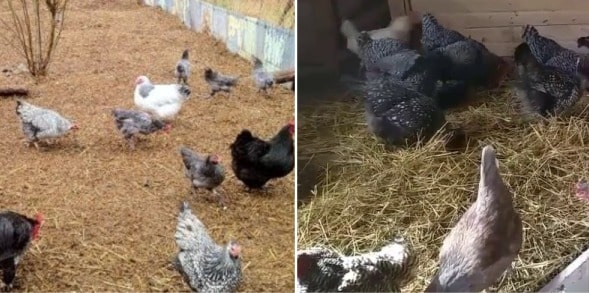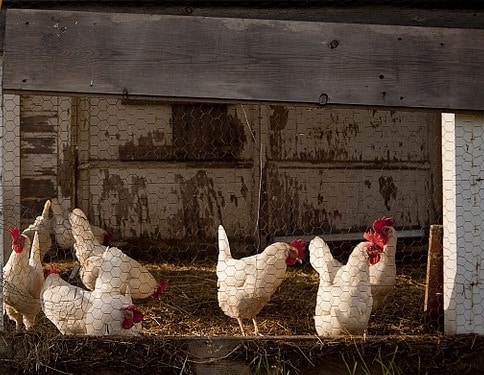Deep Litter Chickens Guide:
Today, let us learn “Raising Chickens in Deep Litter System” or “Deep Litter Chickens”.
What is a deep litter system?
A deep litter system is essentially creating a clean and safe compost heap inside your chicken coop or run. This is done by leaving a thick layer of bedding in the coop or run & adding more bedding on top once the initial layer begins to decompose. This essentially creates a system in which the old bedding dissolves & enriches the soil, in turn saving you the money and hassle of having to buy and replace the bedding on a normal basis. In many ways, a deep litter system is more sustainable, easy to maintain & more cost-effective than many other approaches using animal bedding.
A deep litter system for chickens is an indigenous system of raising chickens whereby, chickens are raised on the floor covered with some specific types of material called beddings or litter materials to prevent the direct contact with the birds & the bare floor.

How does a deep litter system work?
The deep litter system working on the formula by adding more matter to the top layer, so that the coop remains clean, while the bottom layers begin to breakdown & nourish the soil beneath. This procedure tends to work as the chicken scratch, pick and peck at the bedding beneath them, which in turn mixes the material through, promoting aeration, and consequentially, the material develops harmless & healthy parasites that feed on the chicken manure and bedding.
Reasons for poultry farmers fail on the deep litter system
If you have adopted the deep litter system and you cannot get your desired result, I can tell you it is because of the below reasons;
- Poor management of litter materials
- Wrong choice of litter material
- No culling or separating infected chickens
- Nutrient imbalance
- Poor pest management
- Poor handling of feeder & drinkers.
Following points to be considered while adopting a deep litter system;
- The deep litter system should always keep dry.
- Only the right numbers of birds must be housed
- The house must be well ventilated
- The litter should be stirred at least once in a week-wet litter if any, should be replaced immediately with new dry litter & birds must be fed a balanced ratio.
- The time starting deep litter system must be in the dry period of the year as it allows sufficient time (At least two months) for bacterial action.
- Placing of water must be given due attention to keep litter dry.
Points to be considered to raise chickens successfully in a deep litter system:

If you raise chickens successfully in a deep litter system the below points should be considered;
Nutritional Adjustment:
This is very important to the success of your birds in a deep litter system; most poultry farmers do not know that the nutrient necessities of chickens in a deep litter system are different from that of chicken kept in battery cages. Chickens eat to meet their energy requirement is always the reference point when formulating poultry feeds, either with feed formulation software or manually.
Chickens in the deep litter system require more energy in their diet compared to chickens in battery cages; this is because they use up more energy for perching, running, scattering & scratching the ground. Birds in battery cage do not have the privilege to take out these forms of activities; therefore, they conserve more energy. When formulating a diet for your birds in deep litter, try to increase the energy level of the diet to enable the birds to make optimizations.
Read: Layer Poultry Training.
The valuable fertilizer:
This is a valuable economic part with deep litter. Approximately, 35 laying birds can produce in one year about 1 tonne of deep litter fertilizer. The level of nitrogen in fresh manure is about 1%, but on well built-up deep litter it may be around three percent nitrogen (nearly 20% protein). It also contains about 2 percent phosphorus and 2 percent potash, its value is about 3 times that of cattle manure.
Biosecurity:
Biosecurity, which exactly means the safety of living things, is a programme designed to prevent the exposure of birds to disease-causing organisms by reducing introduction & spread of pathogens into and between the farms. Biosecurity in a broader sense encompasses isolation, traffic control, sanitation, vaccination, serological monitoring of diseases & air quality, etc. which will aid in preventing the entry & control the pathogens in and around the farm.
Biosecurity is the cheapest & at the similar time most useful means of disease control available without, which no disease prevention programme will work well. If you do not have biosecurity measures on a poultry farm, you are taking a huge risk. Remember, birds have direct contact with the bedding & anyone visiting your farm, without restrictions, lands on the beddings. This is detrimental to the health of birds.
Avoid direct contact with the birds; use gloves & dispose of mortalities properly by burying and not throwing on the dumping site or pits as it is normally done.
Bedding Materials:
There are different types of bedding materials can use in your poultry farm. There are;
Sawdust:
Sawdust is certainly discouraged by most poultry gurus. Basically, sawdust in dangerous for your flock because it is very powdery & dusty. Sawdust isn’t particularly absorbent and is prone to developing maggots.
One of the disadvantages of using sawdust is its small particle size that can cause respiratory disorder in chickens.
Wood shavings:
There are some fantastic varieties of highly absorbent wood shavings obtainable on the market. Preferably the wood shavings will be small flakes of kiln dried wood. Ideally the wood shaving will have been dust extracted; otherwise, your flock can experience respiratory problems, due to the excess of sawdust. Wood shavings are definitely a popular selection at the moment as it is reasonably absorbent and hygienic for a reasonable price.
Straw and Hay:
Sun-colored straw, with its sweet, earthy smell & springy texture is what many new chicken keepers make for to line their coop and nest boxes.
Sand:
Sand, when used as coop bedding, is an excellent and extremely clean choice for those who have the time to devote to it. While expensive initially, compared to the alternatives listed here, sand as bedding in the coop want only to be replaced once or twice a year if diligently cleaned and contained.
Sand dries very quickly and can be turned over with a rake to employ the deep-litter process or scooped with a cat litter scooper when used in small coops. Be sure to use builder’s sand, as sandbox sand is too fine & tends to clump.
Shredded Leaves:
This is a choice if the leaves are finely shredded so they dry quickly. Whole leaves take a long time to break down and are susceptible to harboring moisture, sticking together & matting. Wet leaves make a slippery surface that could lead to splayed legs or bumblefoot, particularly in younger, growing birds.
Recycled Paper:
A host of reclaimed & recycled man-made materials, such as a shredded newspaper or shredded office paper, are options. While they are free, utilize them with caution. Ink can be toxic to chickens, and office paper is heavily processed & treated. Glossy paper the kind found in magazines & fliers also contains a large amount of ink and can create a matted or slippery surface.
The most commonly used bedding materials are sawdust & wood shaving. Considering the above characteristic of bedding material, wood shaving has been established to be the most suitable bedding material for chickens, especially in the deep litter system.
Feeder and Drinker Management:
Unlike the battery cage system, where an individual bird has its own compartment or feeding space, birds in the deep litter can create a choice of the drinker or feeder that drink & eat from. This feature makes it imperative to have as many feeders & drinker as possible when raising birds on deep litter system.
Save your birds the stress of hustling to drink and feed by providing enough feeders and drinker to allow each bird eats & drinks conveniently. Aside from alleviating stress induced during feeding and eating, you have to ensure the feeders & drinker are clean before serving feed and water.
Remove dirt and excreta from the linings & edges of the feeders and drinkers. Hanging feeders & drinkers are best for deep litter chickens; this feeding and drinking equipment must be up to the level of their breast.
Read: Types of Poultry Feed.
Disease prevention and management:
Routine preventative measures from the next line of defense against disease, after providing a clean & hygienic environment through good poultry farming practices. Preventative measures consist of;
- Vaccination
- Parasite control
- Identifying and treating sick birds
- Separating multi-age flocks
- Practicing routine biosecurity procedures between flocks and staff working with them.
Disease control:
Well-managed deep litter kept in a dry situation with no wet spots around water has a sterilizing action. The level of coccidiosis & worm infestation is much lowering watered, kept in excellent deep litter than with birds or chickens in bare yards & bare floor sheds mainly where water spillage is allowed.
Pest Control
Snake, termites, rodents are the main pests you are likely to encounter in a deep litter system. Keep your farm environment free from bushes & weeds; they harbor pests, particularly snakes. Surround the base of your pen with used engine oil, regularly black in color; it repels termites from getting into the pen; block all holes and crevices.
Advantages of Raising Chickens on a Deep Litter System:
The following are the benefits when you raise chickens on a deep litter system:
- Birds have enough exercise to maintain them healthy.
- Chickens exhibit their natural behaviors which are essential for a good yield.
- Bone disorders, generally associated with battery cage, are completely eliminated.
- Better & uniform feed intake
- Improved utilization of nutrients.
Read: Roof Gardening Ideas.